Canted Quad Headlights










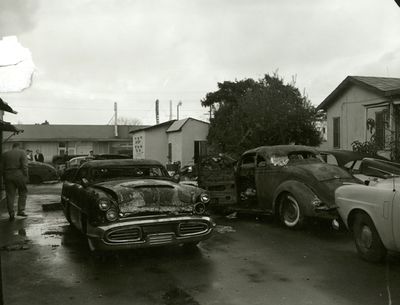








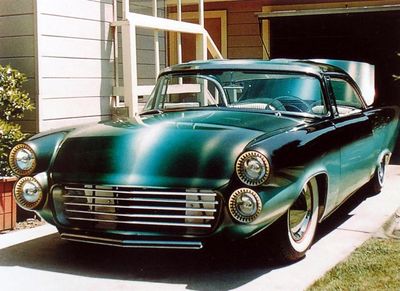






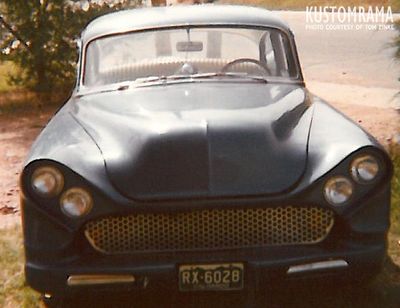


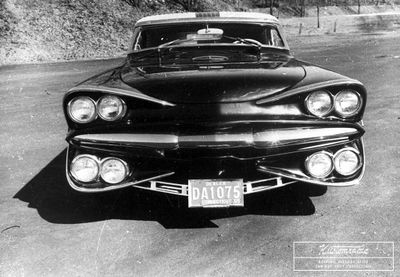

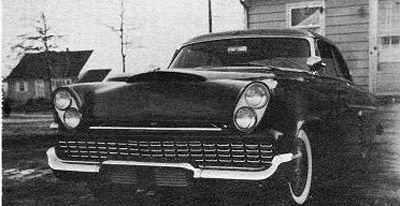


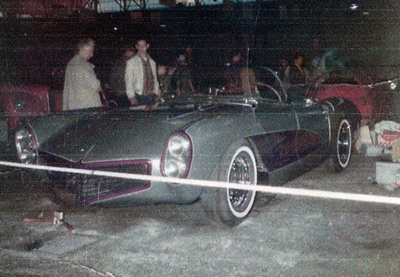
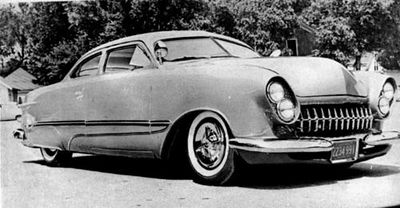




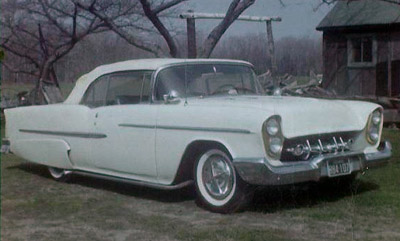
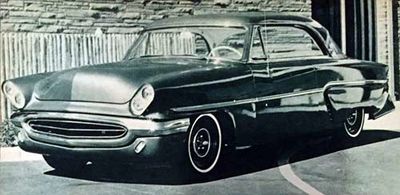
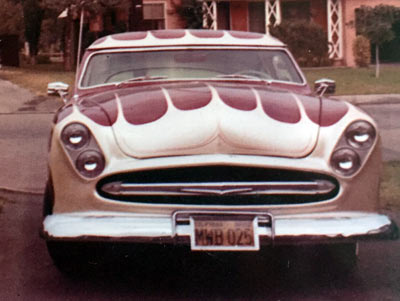
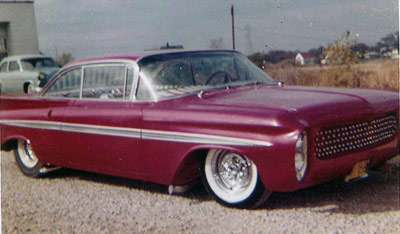






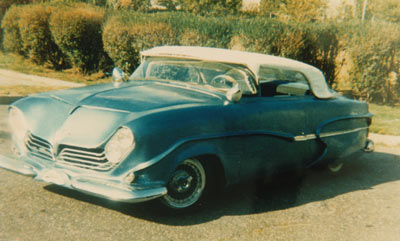
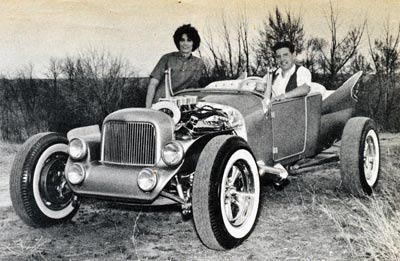
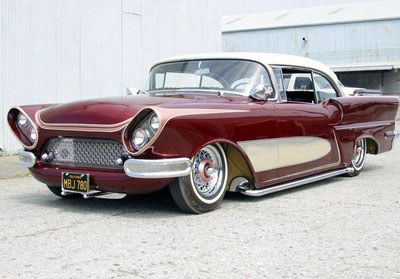
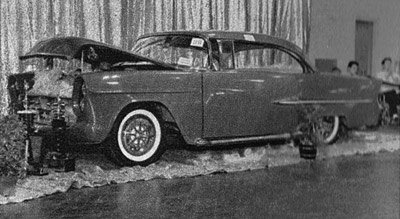


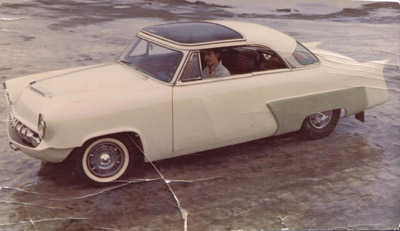




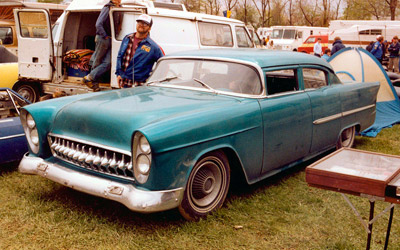

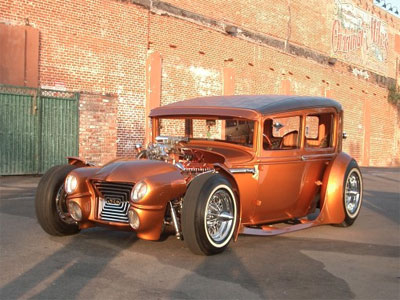
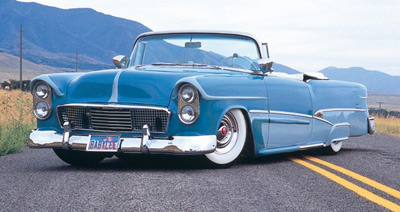
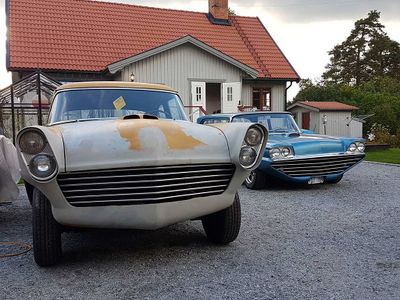

Contents
- 1 The History of Canted Quad Customs
- 2 European Sports Cars and Coachbuilt Customs
- 3 The First Dual Headlights
- 4 Ghia + Chrysler Corporation Experiments with Dual Headlights
- 5 Bertone and the Storm Z-250 Predicts a Dual Headlighted Future
- 6 Ford and GM Follows up with Dual Headlighted Concept Cars
- 7 Barris Kustoms Experiments with Dual Headlights on the West Coast
- 8 Frank Maratta Experiments with Dual Headlights on the East Coast
- 9 Dual Headlights to the People
- 10 The First Canted Quad Headlights
- 11 Quad Light Styling: One of the Hottest Custom Trends of 1958
- 12 Gene Winfield was an Early Adaptor of Canted Quads
- 13 Joe Bailon and Quad Lights in Every Possible Position
- 14 George Barris Predicts More Extreme Quad Lights for 1959
- 15 The One That Got Away
- 16 Canted Quad Headlights Become Mainstream
- 17 The Growth of Canted Quad Customs on the East Coast
- 18 7 of the 10 Best Customs for 1961 had Canted Quad Headlights
- 19 Sweden Jumps on the Canted Quad Bandwagon
- 20 The First Canted Quad Customs in Norway
- 21 Blue Heaven - The Leader of the Pack
- 22 Still Popular Today
- 23 Cars Featuring Canted Headlights
The History of Canted Quad Customs
Photos taken after the tragic fire at Barris Kustoms in December of 1957 reveal an emerging late 1950s custom trend: Canted Quad Headlights. At least two cars in the shop had received this hot modification when the building went up in flames. Where did this trend start? Was George Barris the inventor? Or was he an early adaptor, leading the way for heaps of customizers to come?
European Sports Cars and Coachbuilt Customs
Since the dawn of the automobile, the desire for individuality has been a motivation for customizing cars. It began with rich and famous people commissioning coachbuilders to create unique one-off designs. Back then, "Custom Jobs" were used to describe cars built from the ground up, while a "Restyled Job" defined a stock auto that somehow had been altered from the original design. George Barris started his career watching Northern California customizer Harry Westergard restyle cars in the late 1930s. With Westergard as his mentor, young George set out to restyle his first car in 1941. Like most other men in the trade, European sports cars and coachbuilt customs served as inspiration for Barris and Westergard in the 1940s. In 1951, after moving to Southern California and successfully establishing his own custom body shop, George decided to go to Europe to study automotive styling. Visiting Italy, Germany, and France, his primary purpose was to observe current styling trends and see what some European coachbuilders were up to.
The First Dual Headlights
Italy, especially Turin, seems to be a central place when it comes to the birth of the dual headlight. A couple of years before George Barris arrived in Europe, a wealthy client in Sicily commissioned Italian car design firm and coachbuilder Pininfarina to design a one-off sports car. Known as the Alfa Romeo 6C 2500 SS, the elegant coupe is believed to be the first automobile that adopted dual headlights. Inspiration for the build is said to have come from an Alfa Romeo cabriolet that Pininfarina had developed for Prince Aly Kahn, the husband of Hollywood actress Rita Hayworth.
Ghia + Chrysler Corporation Experiments with Dual Headlights
Ghia is another well-known Turin-based car design firm and coachbuilder that started experimenting with dual headlight designs in the early 1950s. After teaming up with Chrysler Corporation, the Ghia-styled Dodge Firearrow I concept car debuted at the 35th Turin Auto Show in April of 1953. Featuring a pontoon fender-style body, the Firearrow I was a low-slung roadster with dual headlights that were mounted underneath a massive bumper - A bumper that wrapped around the entire body of the car. Unlike anything else in the US at the time, Bob D'Olivo of Motor Trend magazine bowed it as "the most successful meeting of European and US designs." The sporty roadster was introduced to the American public at Chrysler's New York showroom later that year, and an estimated 38,000 people came to check it out. The response was enormous, and in January of 1954, Chrysler president L.L. Colbert announced in Motor Trend that the Firearrow could now be purchased on special order. That never happened, but many of the design elements from the Firearow I, including the pontoon fenders and the dual headlights, found their way onto at least two other Ghia designs in 1953 and 1954; The Alfa Romeo 1900C Sprint Supergioiello and the 1953 Cadillac Series 62 Coupe. The Supergioiello made it into production, and 19 cars are known to have been built. Only two Cadillacs are known to have left the Ghia body shop. One of them supposedly ended up with Hollywood actress Rita Hayworth.
Bertone and the Storm Z-250 Predicts a Dual Headlighted Future
Bertone was another Italian coachbuilder that experimented with dual headlights in the early 1950s, and in 1951 they exhibited the dual headlighted Lancia Aurelia B52 Coupé at the Turin Auto Show. Three years later, in April of 1954, they returned with the Storm Z-250. A US concept car that took home the first prize award for style and design at the show that year. The Storm Z-250 was built by Sports Car Development Corp., a company founded by Fred M. Zeder Jr. and Gene Casaroll. Fred was the son of well-known Chrysler profile Frederick M. Zeder, and the car incorporated as many Chrysler components as possible, including a huge Dodge Hemi engine. While Dodge had predicted a future where dual headlights were placed side by side, the Storm Z-250 introduced dual headlights that were stacked on top of each other. Chrysler designer Hank Kean initially designed the Storm, and a complete chassis was shipped to Italy, where Bertone fabricated the body.
Ford and GM Follows up with Dual Headlighted Concept Cars
The Storm Z-250 never made it into production. Still, quad headlights had come to stay, and in 1954 General Motors debuted two Cadillac concept cars that incorporated dual headlights at their spectacular GM Motorama. Ford Motor Company followed with two vehicles in 1955; The futuristic Ford Mystere, which featured dual headlights placed side by side, and the Lincoln Indianapolis, which featured dual headlights stacked on top of each other.
Barris Kustoms Experiments with Dual Headlights on the West Coast
In California, George Barris realized that four headlight beams were considered futuristic, so sometime before March of 1956, he installed quad headlights on Martin and Morris Srabian's 1954 Ford F-100 truck. Seven years behind Pininfarina, he still beat Detroit production cars by almost a year, and Barris Kustoms is known as the first shop to install dual headlights on a custom. Known as the "Wild Kat," the Srabian Ford was, unfortunately, one of the lost cars in the Barris fire.
Frank Maratta Experiments with Dual Headlights on the East Coast
Frank Maratta was another early customizer experimenting with dual headlight conversions. Based on the East Coast of the US, Frank debuted a customized 1953 Buick Skylark with dual headlights at the 1956 Hartford Autorama. The show took place in February of 1956, and Frank's buddy John Bozio believes he completed the build late in 1955. A close race between the West Coast and the East Coast, and if Frank actually beat George to the finish line, we might have to rewrite the history books.
Dual Headlights to the People
Dual headlights were not legal in all states in the US in 1956. In states where it was legal, cars with quad headlights began selling late in 1956, as the 1957 models were released on the market. Offered as optional installations, Chryslers, DeSotos, Mercurys, Imperials, and Cadillacs could all be bought with quad headlights placed side-by-side. Nash went with dual headlights that were stacked on top of each other, while Lincoln decided to go with two large-diameter headlights above two smaller road lights for their 1957 models.
The First Canted Quad Headlights
By 1958, through the American Manufacturers Association's efforts and the general acceptance of the quad headlight design, all states approved dual headlights as legal equipment for automobiles. It became one of the hottest custom trends of 1958, and if you look through Trend Book's Custom Cars 1958 Annual, you will see lots of cars that have been modified to accept quad headlights. The problem with these conversions was often the width of the fender. To fit a pair of horizontally positioned headlights, you needed a 14-inch width. Vertical installations were a solution for narrow fenders, as long as the headlight was 26 to 27 inches above the ground, as the law required that in most states. In 1958 Lincoln introduced a solution to this problem: canted quad headlights! Or did they really? While canted quad headlights became one of the most striking features of the new 1958 Lincoln, they were old news in Italy. In 1952, Fiat introduced its legendary 8V coupe at the Geneva Salon. Designed by Luigi Rapi, Fiat supposedly produced 34 cars between 1953 and 1954, and the 1954 model featured canted quad headlights.
Quad Light Styling: One of the Hottest Custom Trends of 1958
Back in the US, Custom Cars Magazine stated in their September of 1958 issue that "There's only one styling for headlights these days and that's of the quad light variety." The magazine boldly claimed that "It's predicted that if your custom doesn't now possess these dual lamps - it shortly will." They were right, and it didn't take a long time before quad headlights became a tool many used to upgrade their car's appearance. If you didn't have the skills of George Barris or Frank Maratta or the money it took to hire them to do the job, you could order a bolt-on kit from one of the many accessory manufacturers wanting to earn a buck from the emerging trend.
Gene Winfield was an Early Adaptor of Canted Quads
Canted quad headlights became a short-lived fad in Detroit, but customizers worldwide loved it and adapted the design for more than a decade. "The quad light is here and nothing short of a styling revolution can remove it from the design picture," Gene Winfield told Car Craft Magazine when they asked him about his custom forecasts for 1959. Gene explained that the slanted style of lights was more popular because they worked best on older cars; "We'll be using some '58 and some '59 components. The year of the light doesn't matter much; in many cases they are interchangeable. There are some new styling for sure. For example the '59 version of Lincoln's quads is better than its '58 style and the 59 Chevy version is superior to its '58 styling. But we will use any year and any make. It will depend upon what we plan to do and the way in which they will work into our design." Winfield was an early adaptor of canted quads, a master of the trade, and one of his first canted quad jobs can be seen on the cover of the September 1958 issue of Custom Cars magazine. The car is a 1950 Ford that he restyled for LeRoy Goulart. Goulart's shoebox Ford was a groundbreaking custom, and Custom Cars described it as "One of the most unique adaptions we have encountered is this canted headlight/grille combination for a '50 Ford." Winfield had reworked the entire front end of the car to accept slanted 1957 Imperial headlights that were installed inside a well-thought-out grille cavity. A sinister look. The car was shown at the National Roadster Show in February of 1958, and according to Custom Cars June 1958, "spectators found LeRoy Goulart's latest treatment of quad headlight styling a treat in original custom work." The year of the light didn't matter much for Winfield, and one of his next canted quad builds featured headlight rings made from 1959 Chrysler Crown Imperial hubcaps parts. The famous Jade Idol became Gene Winfield's claim to fame. It took more than a pair of canted quads to help him gain national recognition as a custom car builder, but the headlights play a major role in the car's overall design. Gene installed handmade front fenders that he had rolled in aluminum and dressed up with split level quads on the Jade Idol. He had once again raised the bar, and noted author John DeWitt has later described the Jade Idol as "the apotheosis of an American production car envisioned as pure form." Created during a period of unrestrained expression, DeWitt claims that the Jade Idol is defined as much by what Winfield doesn't do as what he does. On the other end of the scale, you will find Northern California customizer Joe Bailon. DeWitt draws parallels between Bailon's builds with the surrealistic mannequins of Salvador Dali.
Joe Bailon and Quad Lights in Every Possible Position
Car Craft Magazine also asked Bailon about his custom forecasts for 1959. "Chevy is the reason there will be more interest in quad lights this year," he told them. "You'll see customizers devising thousands of ways to use them. Lights will be in every possible position. Lights will be lowered, probably as much as vehicle codes will allow - say 26 to 23 inches above the ground. The Chevy lights will provide the most popular mounting for customs and you will see the use of more chrome around them. On many versions we'll build chromed grilles around them." Best known for his Candy Apple paint jobs, Bailon began customizing cars in the late 1930s. After taking home the National award at the National Roadster Show in 1952 and 1953, he was quickly established as one of the country's top-ranked customizers. Bailon's radical builds started popping up in magazines on both coasts, and one of the wildest builds to ever emerge from his shop, "The Golden Corona," landed the cover of Custom Cars February 1959. The "Golden Corona" was a 1956 Chevrolet convertible that Bailon restyled for Joe Boliba. Featuring 1958 Imperial headlights mounted in a canted position, the car was one of three canted quad customs that were shown at the National Roadster Show in 1958. A photo of the car appeared in the June 1958 issue of Custom Cars, where the author noted that "innovation was keynote of this year's new crop of custom cars."
George Barris Predicts More Extreme Quad Lights for 1959
The third canted quad custom from the 1958 National Roadster Show in Oakland is the Barris Kustoms built Ala Kart. Part custom, part hot rod, the Ala Kart was one of the few cars that survived when fourteen cars were lost in the tragic Barris fire on December 4, 1957. Luckily for owner Richard Peters, the car was parked in a separate room, and it was spared from the fire. The Ala Kart made its debut at the National Roadster Show two months later, where it won the prestigious America's Most Beautiful Roadster award. George Barris predicted that '59 would be the year of the "Integrated Custom," the year when the car will create one impression front to rear; "Quad lights will be more extreme this year," George told the Car Craft reporter. "They will be larger. Spread farther apart and wider. You will see them scooped and worked into the fenders better. For the first time in history the shape of the bulb has become an important part of the headlight design. For example, I've been trying to find someone who will make square bulbs for me. I've got a hundred uses for them." George predicted that everything would conform in 1959; "There will be more interest in lights, bumpers and grille combinations as part of this search for conformity."
The One That Got Away
What about Bobby "Chimbo" Yamazaki's ill-fated 1954 Mercury? Bobby's Mercury was one of the many customs that burned down in the Barris fire. Photos taken after the fire shows the remains of the innovative custom with its canted quad headlights. The Merc was actually in the shop being upholstered by Roy Gilbert. The front end had been restyled before that by Jay Johnston at Jay's Custom Shop, and it might have been done before Ford Motor Company introduced their brand new 1958 Lincoln to the public. Chimbo was supposed to pick the car up the next day. That never happened.
Canted Quad Headlights Become Mainstream
By 1959, canted quad customs started popping up all over the US. It was still not a common modification, but more and more canted quad customs were put on tour and started receiving magazine ink. In Detroit, the Alexander Brothers built a unique grille for Clarence Catallo's 1932 Ford that featured canted 1959 Chevrolet headlights. Bill Hines was another Detroit customizer that experimented with canted quad headlights in the late 1950s, and Bill's nephew, Teddy Zgrzemski, became a victim for one of Hines's wild ideas as he cut up and rearranged the whole front end on his 1954 Ford using welding rods and tubing. Darryl Starbird, Ray Fahrner, Bill Cushenbery, all the big builders back then, experimented with the new trend, building canted quad customs. Korky was no exception, and in 1959, he reworked the front on Maximilian King's 1940 Mercury convertible to house canted quad headlights. Originally restyled in the mid-1940s, nerf bars, canted 1958 Chevrolet taillights, and a scallop paint job was also added to upgrade the appearance of the then outdated custom. Many more customs would be victims of the same transformation in the late 1950s and the 1960s.
The Growth of Canted Quad Customs on the East Coast
Trying to trace the growth and popularity of the trend, we looked through the souvenir program for the 1958 Hartford Autorama; a show often referred to as the National Roadster Show of the East Coast. Held in February of 1958, there are no customs with canted quads listed in the program that year. A year later, two canted quads customs can be found in the souvenir program for the 1959 show. One of these is a 1951 Jaguar that Joe Bailon restyled on the West Coast. In the 1960 program, there are four cars with canted quads listed. Twice as many as the year before! In 1961, the number grew to at least 13—a whopping 225% growth.
7 of the 10 Best Customs for 1961 had Canted Quad Headlights
1961 was also the year Leif Wendel, Örjan Lindberg, and Staffan Lindberg pooled their resources and talent together and bought a 1955 Ford Sunliner in Sweden. Inspired by the cars they had admired in Hot Rod and Car Craft Magazine, the trio from Hammarbyhöjden just outside of Stockholm began restyling the Ford after their likings and skills. A mild iteration, shaved for chrome and dressed up with a custom-made grille, was completed for the 1962 season. By then, canted quads were hotter than ever in the US, and 7 of the 10 cars Car Craft magazine had nominated as "The 10 Best Custom for 1961" featured canted quads. In the same magazine, they asked the nation's top customizers about their custom forecasts for 1962. Gene Winfield predicted that small bumpers, rolled pans, and new headlights would give 1962 customs a new eye appeal.
Sweden Jumps on the Canted Quad Bandwagon
Back in Sweden, the Wendel-Lindberg Ford was a work-in-progress, and the front and the rear of the car were radically restyled before it hit the road with a bronze metallic paint job in 1963. Gone was the front bumper, and the car had now received a tube grille, a rolled pan, and canted quad headlights from a 1959 Rambler, just as Gene Winfield predicted. The Wendel-Lindberg Sunliner was one of the first fully customized cars in Sweden. The kids loved it, and it has become a pioneer build when it comes to what many today consider a signature Swedish 1960s custom.
The First Canted Quad Customs in Norway
Around the same time, across the border to Norway, Per Ivar Kolgrov was practicing his metalwork and butcher skills on an older 1948 Mercury convertible. The front fenders on Per Ivar's Mercury were cut down and modified to accept a fashionable grille-headlight combination that Joe Bailon had forecasted for 1959. The installation consisted of chromed tubes and 1964 Fiat 1500 headlights mounted in a canted position. The Kolgrov Mercury was a radical custom when it hit the streets of Oslo in 1964, and it was quite a sensation when he actually got it through the licensing department. Oslo was a hotbed when it came to Norwegian hot rods and customs in the 1960s, but things were going on in other parts of the country as well. Further, up north, in Trondheim, legendary custom painter Einar Valsjø was busy restyling a 1952 Mercury. Completed in 1965, Einar's Mercury incorporated a bumperless front-end design that he had dressed up with canted quad headlights and a 1954 Chevrolet grille bar. It looked like it came straight out of Stockholm, and in Norway, it is often referred to as the first custom car north of Sinsenkrysset.
Blue Heaven - The Leader of the Pack
In Sweden, the Wendel-Lindberg Sunliner changed hands in 1965, and it went on to become a famous custom widely known as The Blue Heaven. A car credited as an inspiration for numerous similar-styled Swedish customs that followed it in the 1960s and the 1970s.
Still Popular Today
You don't see many canted quad customs built in the US after the muscle cars took over the scene in the 1960s. The trend never really took off in Norway before things morphed into custom-painted muscle cars and vans, so I think it is safe to say that the trend was born in Italy, matured in California, and kept alive in Sweden, where a few customs with canted quads still are being built today. We haven't found any quotes from Motor Trend's Bob D'Olivio about Swedish customs of the 1960s, so we let it be up to you to decide how successful meetings they are of European and US design!
Cars Featuring Canted Headlights
Larry Hughes 1926 Ford Model T Roadster Pick Up - The Bomber
Junichi Shimodaira's 1930 Ford Model A Tudor Sedan - Rod Riguez
Maximilian King's 1940 Mercury Convertible
Louie Stojanovich's 1947 Plymouth Club Coupe
Per Ivar Kolgrov's 1948 Mercury Convertible
Lloyd C. Hammond's 1949 Ford - The Majestic Lady
Tom Gibbons' 1949 Ford Tudor - The Orchid Lady
Lloyd Myers' 1949 Mercury Convertible
George Egan's 1950 Ford Convertible - The Apollo
Harold Hardin's 1950 Plymouth Convertible
Einar Valsjø's 1952 Mercury
John Knox's 1953 Buick Skylark Convertible
Bo Thalinsson's 1953 Ford Sunliner Convertible
Ed Pogue's 1953 Ford Hardtop - The Glitra
Buddy Katlik's 1953 Plymouth 4-Door Sedan
Gerald Twamley's 1954 Chevrolet 210 2-Door Sedan
John Nadzon's 1954 Mercury - The Mysterian
Richard Piscatelli's 1954 Mercury
Sven Blüme's 1954 Plymouth Convertible
Roy Abendroth's 1955 Buick Century - The BuSonic
Arne Lindstrand's 1955 Chevrolet
Barry Atkins' 1955 Chevrolet
Emory Ashpaugh's 1955 Chevrolet - The Krimson Kart
John McLaughlin's 1955 Chevrolet
Nick Phillips' 1955 Chevrolet Convertible
Stan Makrush's 1955 Chevrolet Convertible
Sal Consiglio's 1955 Ford
Les Mullen's 1956 Chevrolet Corvette - Dominique
Dave Puhl's 1956 Ford Thunderbird - The Hybrid Bird
Leroy Kemmerer's 1956 Mercury - The Jade Idol
Marlyn Englert's 1956 Chevrolet Convertible
Adrienne Hooper's 1956 Mercury Converible - The Wild One
Ken Sowers' 1956 Plymouth
Bill Shelley's 1957 Chevrolet Corvette - "Bali Hi"
Joe Roth's 1959 Chevrolet Impala
Did you enjoy this article?
Kustomrama is an encyclopedia dedicated to preserve, share and protect traditional hot rod and custom car history from all over the world.
- Help us keep history alive. For as little as 2.99 USD a month you can become a monthly supporter. Click here to learn more.
- Subscribe to our free newsletter and receive regular updates and stories from Kustomrama.
- Do you know someone who would enjoy this article? Click here to forward it.
Can you help us make this article better?
Please get in touch with us at mail@kustomrama.com if you have additional information or photos to share about Canted Quad Headlights.
This article was made possible by:
SunTec Auto Glass - Auto Glass Services on Vintage and Classic Cars
Finding a replacement windshield, back or side glass can be a difficult task when restoring your vintage or custom classic car. It doesn't have to be though now with auto glass specialist companies like www.suntecautoglass.com. They can source OEM or OEM-equivalent glass for older makes/models; which will ensure a proper fit every time. Check them out for more details!
Do you want to see your company here? Click here for more info about how you can advertise your business on Kustomrama.






